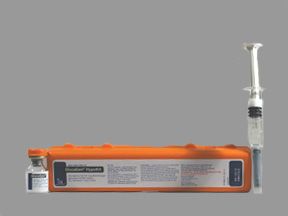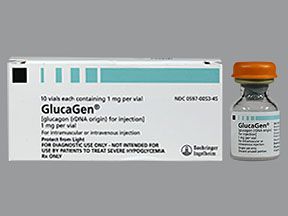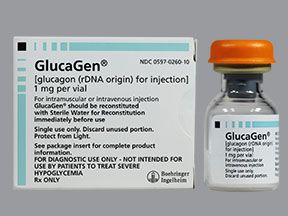GlucaGen (glucagon) is a brand-name prescription medication. The Food and Drug Administration (FDA) has approved it to:
- treat severe hypoglycemia (low blood sugar) in adults and children who have diabetes
- pause movement of the digestive tract during certain radiology exams in adults
GlucaGen belongs to a class of drugs known as glucose-elevating drugs. The generic version of GlucaGen is called Glucagon.
GlucaGen comes as a powder in a vial. This is mixed with sterile water and is given as certain types of injections. To treat severely low blood sugar, you, a caregiver, or a healthcare professional will use a GlucaGen HypoKit. It contains the vial and a syringe of sterile water. Healthcare professionals use GlucaGen vials or a GlucaGen Diagnostic Kit for radiology exams. To learn more, see “GlucaGen forms” in “GlucaGen dosage” below.
For information about the dosage of GlucaGen, including its strength and how the drug is given, keep reading. For a comprehensive look at GlucaGen, see this article.
This article describes typical dosages for GlucaGen provided by the drug’s manufacturer. When taking GlucaGen to treat severely low blood sugar, always follow the dosage prescribed by your doctor. If you’re receiving the drug for a radiology exam, a healthcare professional will administer the GlucaGen dosage that’s right for you.
Below is information about GlucaGen’s recommended dosage for its approved uses.
GlucaGen forms
GlucaGen comes as a powder in a single-dose vial.
To treat severely low blood sugar. For this use, GlucaGen comes as a part of a kit called GlucaGen HypoKit. It contains the vial and a syringe that’s prefilled with sterile water. You or a caregiver will mix the powder and sterile water, then give the drug as a subcutaneous injection or an intramuscular injection. Your doctor can train you and your caregiver on how to give the injections.
In some cases, a healthcare professional may need to treat you for severely low blood sugar. They may give you GlucaGen as an IV injection.
For use with certain radiology exams. For this purpose, a healthcare professional may use GlucaGen alone or the GlucaGen Diagnostic Kit. The kit includes the GlucaGen vial and a vial of sterile water. They’ll give you GlucaGen as an intramuscular injection or IV injection.
GlucaGen strength
GlucaGen comes in one strength of 1 milligram (mg).
Typical dosages
The following information describes dosages that are commonly used or recommended. However, be sure to take the dosage your doctor prescribes for you. Your doctor will determine the best dosage to fit your needs.
Dosage for severely low blood sugar
When used to treat severe hypoglycemia in adults, the recommended dosage of GlucaGen is 1 mg [1 milliliter (mL) of solution] as needed. For this use, you or a caregiver will use a GlucaGen HypoKit and give the drug as either a subcutaneous injection or intramuscular injection.
If you or a caregiver have had to use GlucaGen, call 911 or the local emergency number right away. Severely low blood sugar is a medical emergency. It’s possible that your blood sugar may drop again after you receive the drug.
If the dose of GlucaGen does not work, a second dose may be given 15 minutes after the first dose. This is while you wait for medical help to arrive.
If the second dose doesn’t help enough, a healthcare professional may give you GlucaGen as an IV injection.
Dosage for use with certain radiology exams
When GlucaGen is used for certain radiology exams in adults, a healthcare professional will use GlucaGen vial alone or the GlucaGen Diagnostic Kit. The recommended dosage depends on the section of digestive tract being studied.
To pause movement of the stomach or small intestine, the recommended dosage of GlucaGen is:
- 0.2 to 0.5 mg (0.2 to 0.5 mL of the solution) given as an IV injection or
- 1 mg (1 mL of the solution) given as an intramuscular injection
To pause movement of the colon, the recommended dosage of GlucaGen is:
- 0.5 to 0.75 mg (0.5 to 0.75 mL of the solution) given as an IV injection or
- 1 to 2 mg (1 to 2 mL of solution) given as an intramuscular injection
Children’s dosage
For dosage in children with severe hypoglycemia, see details in the chart below. (Kilograms is abbreviated as kg.)
| Age and weight | Dose* |
| Children who weigh 25 kg† or more | 1 mg (1 mL of the solution) |
| Children who weigh less than 25 kg | 0.5 mg (0.5 mL of the solution) |
| Children ages 6 years and older whose weight is not known | 1 mg (1 mL of the solution) |
| Children younger than age 6 years whose weight is not known | 0.5 mg (0.5 mL of the solution) |
* Dose may be given as a subcutaneous injection or an intramuscular injection.
† 25 kg is about 55 pounds (lb).
If you’ve had to give GlucaGen to your child, call 911 or the local emergency number right away. Severely low blood sugar is a medical emergency. It’s possible that your child’s blood sugar may drop again after they receive the drug.
If the dose of GlucaGen does not work, a second dose may be given 15 minutes after the first dose. This is while you wait for medical help to arrive.
If the second dose doesn’t help enough, a healthcare professional may give your child GlucaGen as an IV injection.
GlucaGen is not approved to be used in children for certain radiology exams. It’s not known if the drug is safe for this use in children.
Long-term treatment
GlucaGen is not meant to be used as a long-term treatment. The drug is used as needed to treat severely low blood sugar during a medical emergency and to aid certain radiology exams.
The GlucaGen dosage your doctor prescribes for severely low blood sugar will depend on several factors. The dosage a healthcare professional uses for certain radiology exams also depends on certain factors. The factors for these uses include:
- what condition GlucaGen is used to treat
- your age
- weight (for children)
Other medical conditions you have can also affect your GlucaGen dosage.
Here’s some information about how GlucaGen is used for severely low blood sugar and certain radiology exams.
GlucaGen for severely low blood sugar. To treat severely low blood sugar, GlucaGen comes as part of a kit called GlucaGen HypoKit. The kit contains a vial of GlucaGen and a disposable syringe that’s prefilled with sterile water. You or a caregiver will:
- mix Glucagen and the sterile water to form a solution, then
- give the drug as a subcutaneous injection or an intramuscular injection in the upper arms, thighs, or buttocks
Your doctor can train you and your caregiver on how and when to give GlucaGen injections.
If you or a caregiver have had to use GlucaGen, call 911 or the local emergency number right away. Severely low blood sugar is a medical emergency. It’s possible that your blood sugar may drop again after you receive the drug.
If the dose of GlucaGen does not work, a second dose may be given 15 minutes after the first dose. This is while you wait for medical help to arrive.
If a healthcare professional needs to treat you for severely low blood sugar, they may give you GlucaGen as an IV injection.
For more detailed information about how to inject GlucaGen, refer to these instructions from the manufacturer.
GlucaGen for certain radiology exams. When GlucaGen or the GlucaGen Diagnostic Kit is used for certain radiology exams, a healthcare professional will give you the drug. You’ll receive it as an intramuscular injection or IV injection before or during the exam. Your doctor can tell you more.
Accessible drug labels and containersIf you’re having trouble reading your prescription label, talk with your doctor or pharmacist. Some pharmacies offer labels with large print, Braille, or a code you scan with a smartphone to convert text to speech. If your local pharmacy doesn’t have these options, your doctor or pharmacist might be able to recommend a pharmacy that does.
If you use more GlucaGen than your doctor prescribes, you may develop serious side effects.
It’s important that you don’t use more GlucaGen than your doctor advises.
Symptoms of an overdose
Overdose symptoms of GlucaGen can include:
- nausea
- vomiting
- loss of movement in the digestive tract
- increased blood pressure
- increased pulse
- low potassium level
If you take more than the recommended amount of GlucaGen
Call your doctor right away if you believe you’ve taken too much GlucaGen. Another option is to call the American Association of Poison Control Centers at 800-222-1222 or use its online tool. If you have severe symptoms, immediately call 911 or your local emergency number, or go to the nearest emergency room.
The dosages in this article are typical dosages provided by the drug manufacturer. If your doctor recommends GlucaGen for you, they’ll prescribe the dosage that’s right for you. Always follow the dosage that your doctor prescribes for you.
As with any drug, never change your dosage of GlucaGen without your doctor’s recommendation. If you have questions about the dosage of GlucaGen that’s right for you, talk with your doctor.
Besides learning about dosage, you may want other information about GlucaGen. These additional articles might be helpful to you:
- More about GlucaGen. For information about other aspects of GlucaGen, refer to this article.
- Side effects. To learn about side effects of GlucaGen, see this article. You can also look at the GlucaGen prescribing information.
- Drug comparison. Find out how GlucaGen compares with Baqsimi.
- Details about your condition. For details about diabetes, see our diabetes hub and list of related articles.
Disclaimer: Medical News Today has made every effort to make certain that all information is factually correct, comprehensive, and up to date. However, this article should not be used as a substitute for the knowledge and expertise of a licensed healthcare professional. You should always consult your doctor or another healthcare professional before taking any medication. The drug information contained herein is subject to change and is not intended to cover all possible uses, directions, precautions, warnings, drug interactions, allergic reactions, or adverse effects. The absence of warnings or other information for a given drug does not indicate that the drug or drug combination is safe, effective, or appropriate for all patients or all specific uses.



